Google Maps has become an essential source of information for people who visit or live in a city. While Tripadvisor targets tourists, Google Maps aims to be used by everyone to review any type of activity or location, hotels and restaurants of course, but also public toilets, bus stops, dentists and schools.
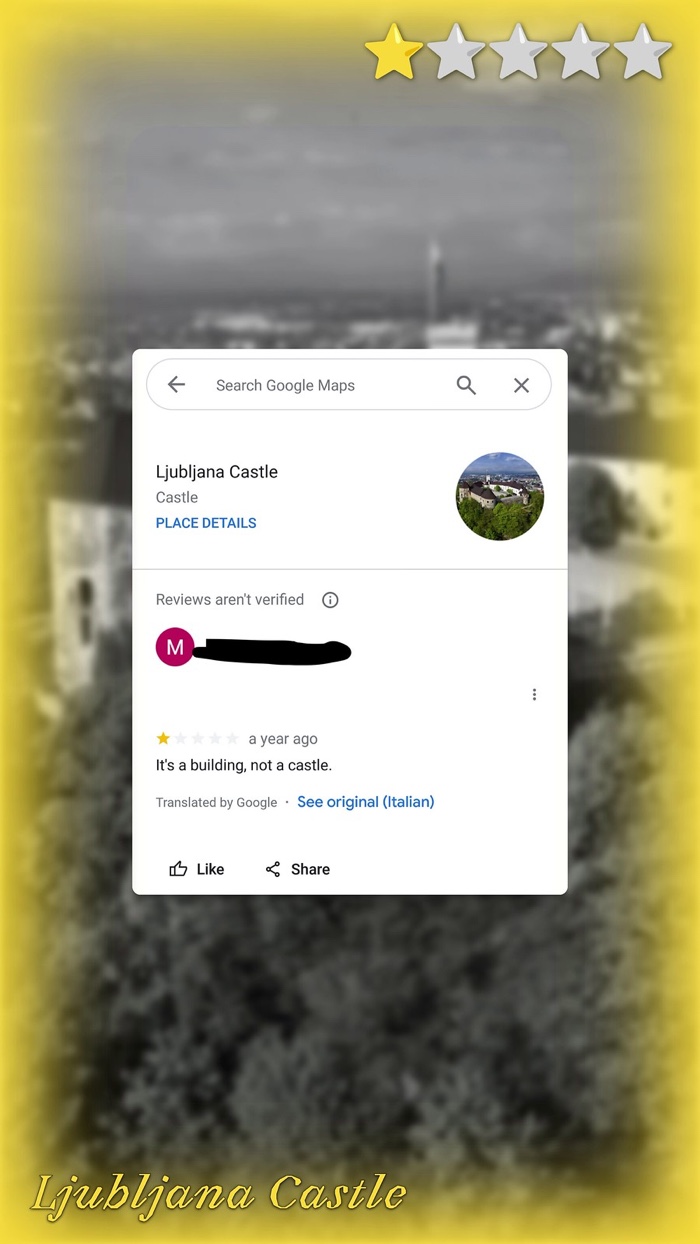
Selena Savi?, Gordan Savi?i? and !Mediengruppe Bitnik, 1  Review Tour Ljubljana, still, 2024. Image: courtesy the artists
Review Tour Ljubljana, still, 2024. Image: courtesy the artists
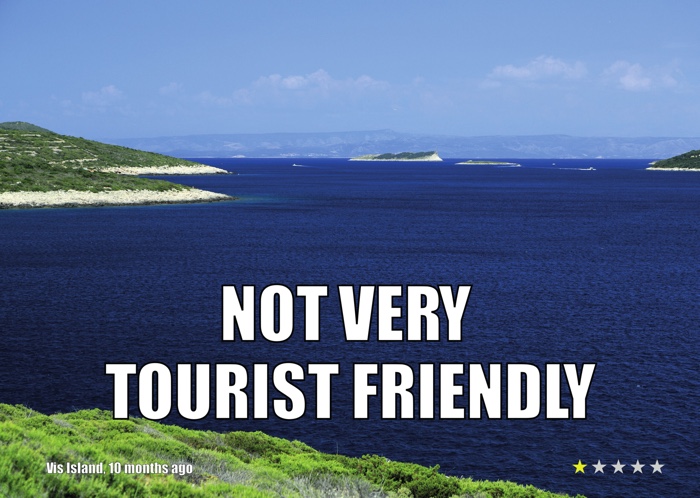
Selena Savi?, Gordan Savi?i? and !Mediengruppe Bitnik, One  Review Tour on the island of Vis, 2023
Review Tour on the island of Vis, 2023
One Star Review Tour, by Selena Savi?, Gordan Savi?i? and !Mediengruppe Bitnik, looks at how rating systems shape the perception and experience of a place.
In data-driven environments, credit scores, social influence rankings and product/service reviews dictate choices regarding, for example, selecting a doctor, shopping or dining out. One of the most widely used evaluation schemes online is the five-star system.
The popularity of the rating system stems from its simplicity and the way it transforms a personal opinion into a number that is easy to grasp and aggregate with others. What makes these reviews particularly interesting in a map-making context is that maps have always lacked objectivity, they are based on their creator’s worldview. Following that, one can argue that Google Maps reflects the perspective of a commercially-oriented tech giant based in California. But what happens when you are not just using this type of map but contributing to it? What happens when the map is enhanced by an accumulation of personal opinions and subjective reviews?
One well-known consequence of the five-star system is its impact on the visibility and revenue of independent businesses. Countless expert articles explain to business owners how they can boost their rating and optimise their business profile. Appearing high on Google’s map pack requires time and commitment. However, not all sites, services or products can align with conventional consumer demands. To obtain the five-star rating, they must be easy to consume, readily available, impressive, fun or “instagrammable”. And while privately owned companies can fight bad online reviews, public spaces can hardly talk back or ask Google to leave them alone.
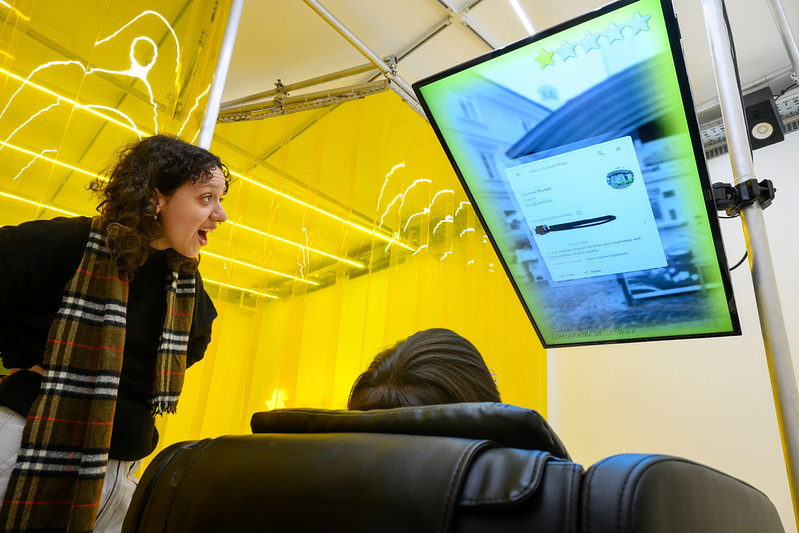
Opening of the exhibition One Star Review Tour. Photo: Domen Pal / Aksioma
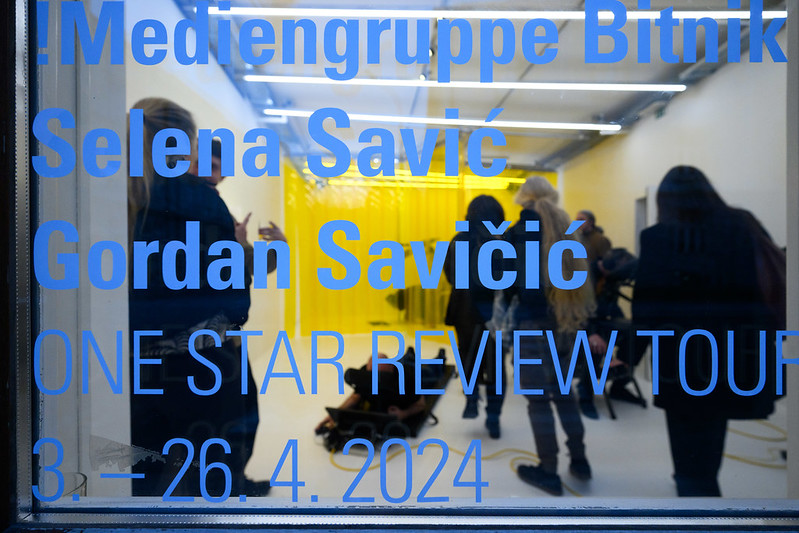
Opening of the exhibition One Star Review Tour. Photo: Domen Pal / Aksioma

Selena Savi?, Gordan Savi?i? and !Mediengruppe Bitnik, 1  Review Tour Secrets, still, 2024. Image: courtesy the artists
Review Tour Secrets, still, 2024. Image: courtesy the artists
One Star Review Tour, an exhibition that recently closed at Aksioma | Project Space in Ljubljana, explored the place of public spaces in the “reputation economy.” What does it mean when places we love are scrutinised and publicly rated? What are the politics of rating systems? What are the real, tangible effects of personal reviews?
The show featured a video of 1  Review Tour Ljubljana where you get to see and hear ONLY negative reviews of public places in the city while sitting on a fully automated massage chair; 1
Review Tour Ljubljana where you get to see and hear ONLY negative reviews of public places in the city while sitting on a fully automated massage chair; 1  Review Tour Secrets, an ASMR video that takes you on a tour of Ljubljana with comments related to the way algorithms shape our experience of places; and 1
Review Tour Secrets, an ASMR video that takes you on a tour of Ljubljana with comments related to the way algorithms shape our experience of places; and 1  Review Tour Browser Extension that gives you access to only 1
Review Tour Browser Extension that gives you access to only 1  reviews on Google Maps.
reviews on Google Maps.
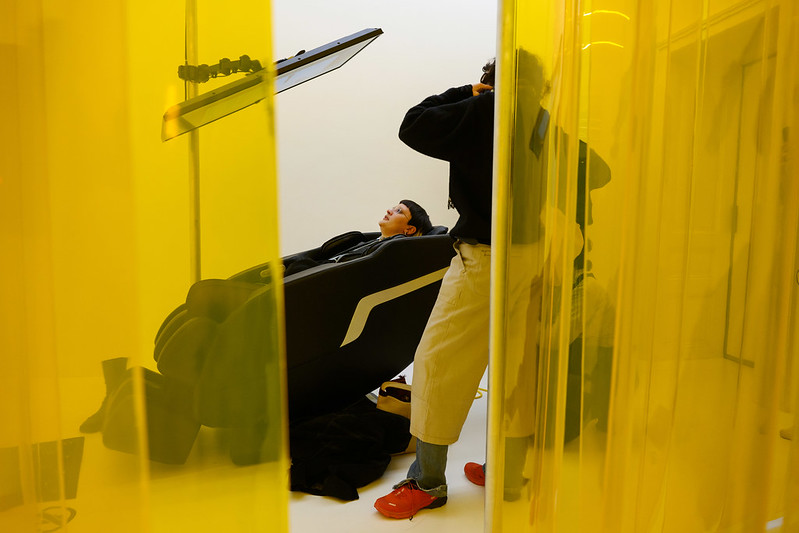
Opening of the exhibition One Star Review Tour. Photo: Domen Pal / Aksioma
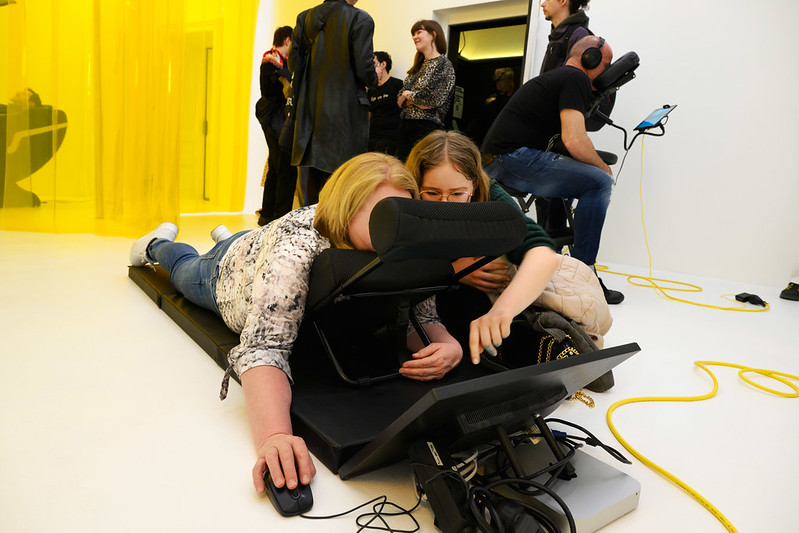
Opening of the exhibition One Star Review Tour. Photo: Domen Pal / Aksioma
Following this interview with Selena Savi?, Gordan Savi?i? and !Mediengruppe Bitnik, i started looking at reviews of bus stops in the city where i live. I’ll never look at bus stops the same way.
Hello, Selena Savi?, Gordan Savi?i? and !Mediengruppe Bitnik! How did the four of you get to work together on the One Star Review Tour’? Did each of you have a different role in the project development?
Domagoj Smoljo: Gordan and Selena visited us last summer on the island of Vis where we were working on the ISSA project. ISSA stands for Island School of Social Autonomy and we see it as a place that brings together a community of artists, thinkers and activists who want to imagine and cultivate other forms of knowledge production and sharing.
Carmen Weisskopf: Gordan, Doma and I also work together on a research project at the Zurich University of the Arts. So we were engaged in an ongoing conversation about data and ambiguity. So then, when we spent some time together for ISSA on an island that is massively touristic, where tourism is part of everyone’s income in one way or another. We were intrigued by the amount of data this tourism produces. And the data produces harsh consequences: For local inhabitants, worrying about how many stars their apartment might get is part of their daily preoccupations. We would read reviews on Google Maps for the places we went to and we started wondering.
Selena Savi?: We very quickly noticed that the public places where we were hanging out had reviews, but no one had bothered to respond to the negative or inaccurate remarks. Unlike restaurants, where you could find all these personal and detailed responses, often to defend the restaurant. That was not the case for public spaces. Nobody was defending the beaches or opposing reviews that said, “This beach is too quiet” or “There’s nothing there”.
Gordan Savi?i?: Vis is a very specific place. It’s a tiny island, hence the space you can interact with is limited. For some beaches, it became very clear that you can find the Instagram effect that makes tourists want to visit the place and be photographed on this specific, tiny beach. A couple of kilometres further, you can find abandoned beaches, since no one has added a placemark to Google Maps. One of the abandoned beaches had a one-star review with the message “Nothing there.” People come in with super high expectations. They expect a beach bar, toilets, etc.
Selena: And anchoring for your boat!
Gordan: You could just enjoy a nice beach, but if you look through Google Maps, you have the feeling that it is an awful place. The abandoned beach even disappeared as a placemark because its rating was so low. When tourists go to the island, one of the first things they check out is their surroundings and, for many, this surrounding is filtered by Google Maps’ top-down perspective. That’s when you realise the distortions of reality.
Could it be that the locals are the ones uploading negative reviews because they want to keep the beach to themselves?
Doma: We thought about that too. It could be a strategy. On the main island, there are reviews by people who say, “Hey! Don’t come here! The other island is much better!” You notice the humour and perhaps the idea is to keep people away and keep a bit of that paradise to themselves.
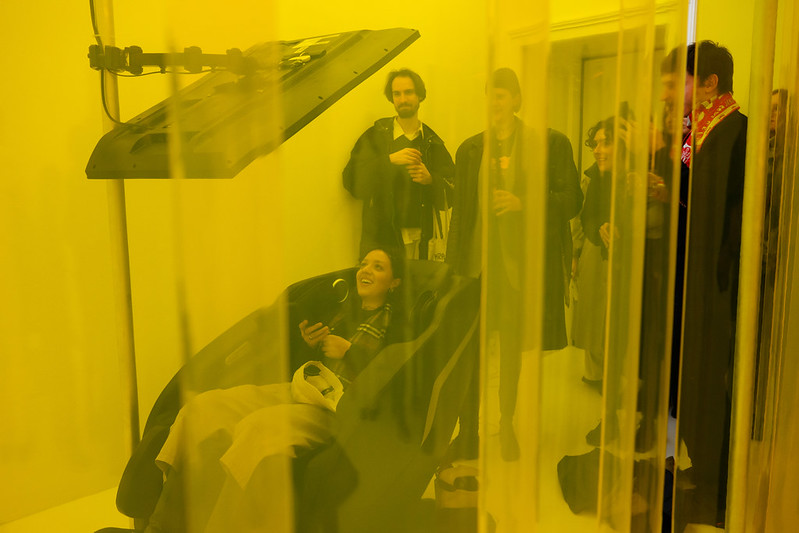
Opening of the exhibition One Star Review Tour. Photo: Domen Pal / Aksioma
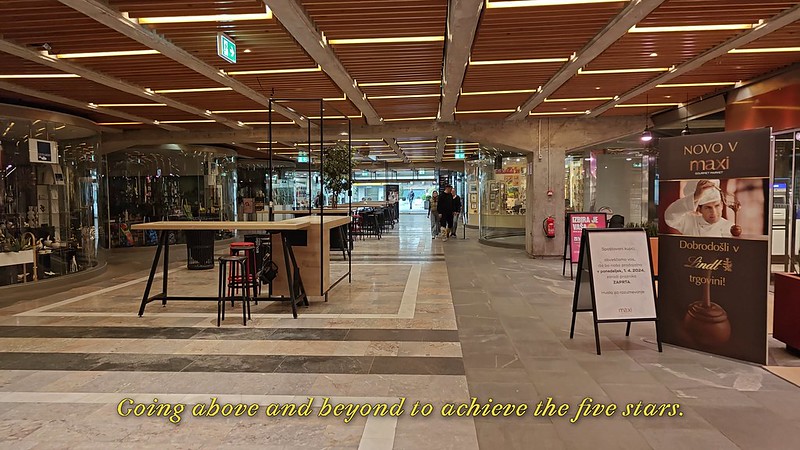
Selena Savi?, Gordan Savi?i? and !Mediengruppe Bitnik, 1  Review Tour Secrets, still, 2024. Image: courtesy the artists
Review Tour Secrets, still, 2024. Image: courtesy the artists
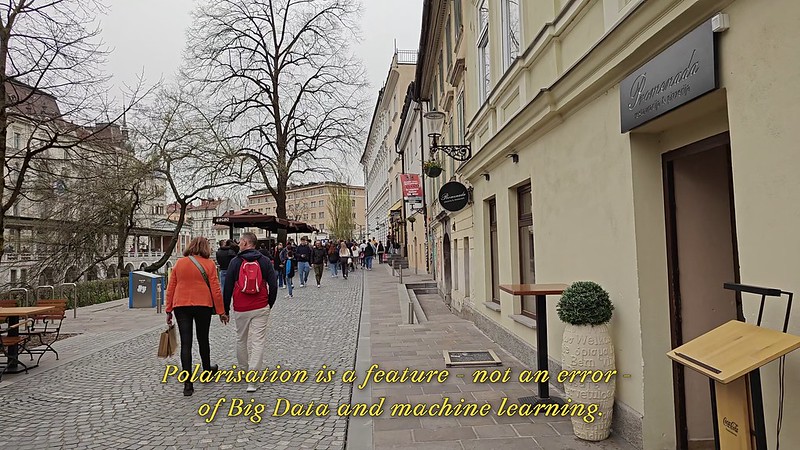
Selena Savi?, Gordan Savi?i? and !Mediengruppe Bitnik, 1  Review Tour Secrets, still, 2024. Image: courtesy the artists
Review Tour Secrets, still, 2024. Image: courtesy the artists
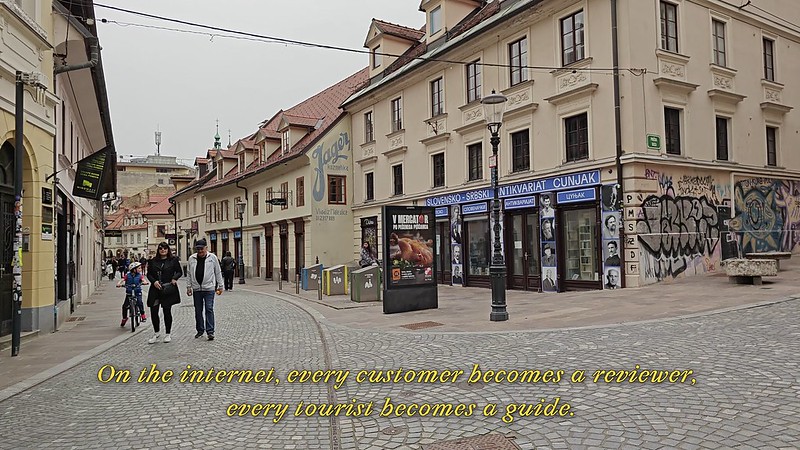
Selena Savi?, Gordan Savi?i? and !Mediengruppe Bitnik, 1  Review Tour Secrets, still, 2024. Image: courtesy the artists
Review Tour Secrets, still, 2024. Image: courtesy the artists
Vis is very different from Ljubljana, especially now, during what is probably not the most touristic season. How different is it in a big-ish city like Ljubljana, where the local economy doesn’t rely so heavily on tourism?
Carmen: Ljubljana is a city, and it’s not so dependent on tourism. Nevertheless, everything is rated there too. For this work, we limited our research to public spaces. Every bridge -Ljubljana has many bridges- has ratings, including negative ones. The castle has plenty of ratings. In some of them, people debate whether or not it is a castle. There are a lot of comments similar to the ones we observed on Vis. But more than is the case with the small community on Vis, local people living in cities tend to use Google Maps as a complaint book about infrastructure and public services that do not work well. In Berlin, for example, all the public transport lines have ratings written by local people.
While users of online rating services generate a lot of valuable information on public services, this data does not generate any kind of political movement. And for Google, it is just data. And any data is good. I would say that both in Vis and Ljubljana, we found the same misunderstandings. In both places, there is a similar kind of anticipation towards space where everything has to be accessible, easily consumable, fast, ready, written in English, etc.
Doma: We also wanted to understand the particular colonialist culture that Google brings in. That’s something that we could feel on the island of Vis and we were interested to see if it was present in Ljubljana too. On Vis, we had a smaller dataset, so it was easier to navigate and identify it. But the influence is present in Ljubljana. In high street cafes, for example, because they depend on these positive ratings to survive.
Selena: There is also something like a rating language. We practiced it also with each other, for fun… It’s an interesting exercise to write your thoughts in the form of reviews. It’s part of this imperial effect where you adopt a centralised mode of communication that is the only liveable way to exist. You can’t write reviews that do not comply with these tacit language rules, they simply won’t catch people’s attention.
It is also important to note that what is considered public space, and expectations from it are not the same everywhere (not universal). What is similar in both Ljubljana and Vis is the disappointment. In Vis, some beaches are sources of disappointment. In Ljubljana, it’s the bridges. Bridges in that city are expected to be enjoyable places so they get rated for their beauty. The size of the dragons, in particular, seems to be a source of frustration. People expect them to be bigger. Everywhere is different.
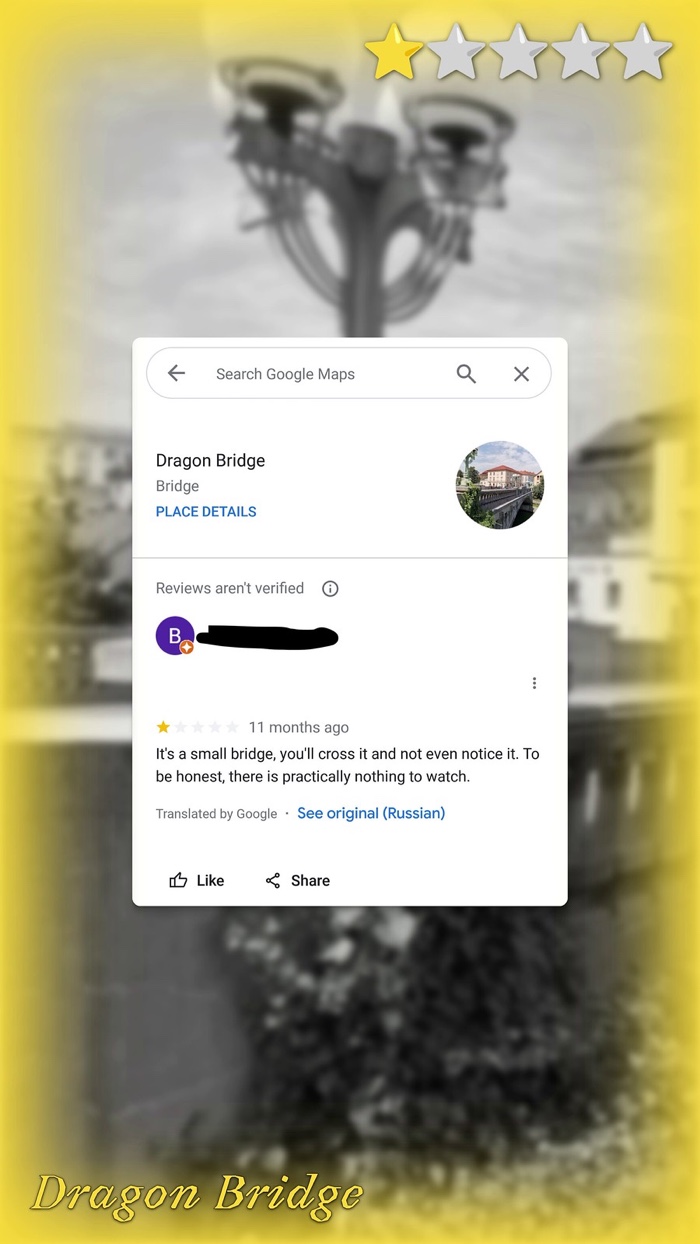
Selena Savi?, Gordan Savi?i? and !Mediengruppe Bitnik, 1  Review Tour Ljubljana, still, 2024. Image: courtesy the artists
Review Tour Ljubljana, still, 2024. Image: courtesy the artists
I had never thought about the fact that even public spaces could be reviewed on Google Maps.
Doma: The difference between the public space and the private space is that the private space can be claimed by somebody. As a business owner, you can fight any negative review by answering, apologising or defending yourself. Public space, on the other hand, has no voice. It is not part of Google Maps’ worldview.
Selena: Google only cares about the spaces that can generate reviews. You can create a marker. They will then verify that you are a valid Google user and that this place really exists in that location. After that, you can claim this to be a place. In Vis, we started to look into reviews for a place called “Cave with a Beach”. It’s literally a cave and a beach. But the problem for reviewers of Cave with a Beach was that there was nothing more than a cave and a beach. Maybe for the person who put it on Google Maps, it was just a joke.
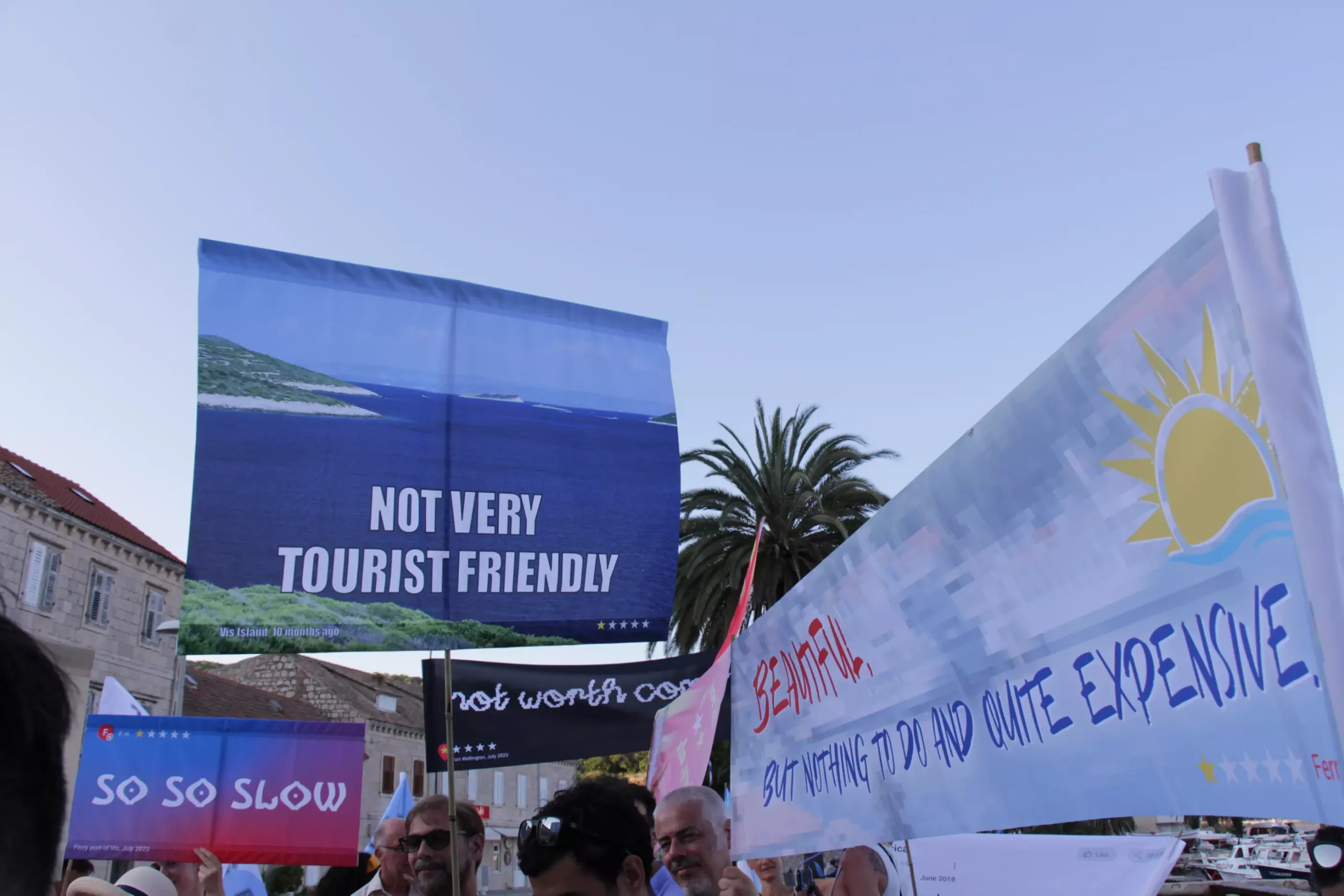
Selena Savi?, Gordan Savi?i? and !Mediengruppe Bitnik, One  Review Tour on the island of Vis, 2023
Review Tour on the island of Vis, 2023
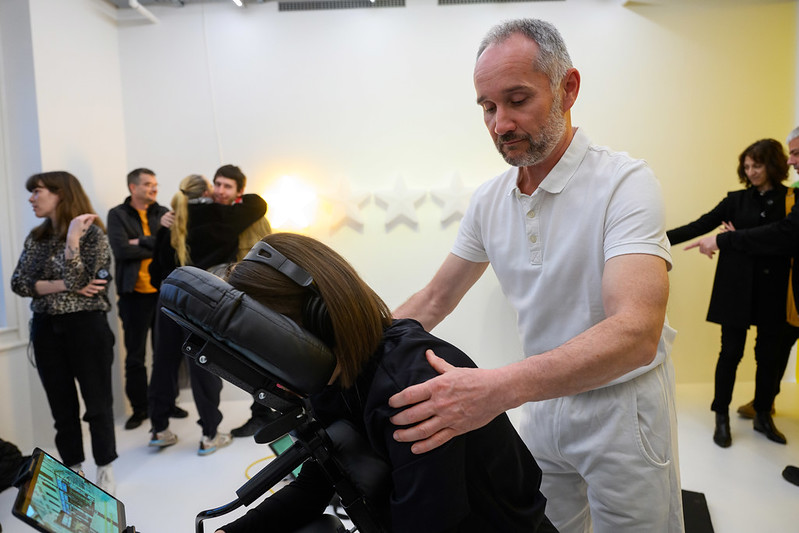
Opening of the exhibition One Star Review Tour. Photo: Domen Pal / Aksioma
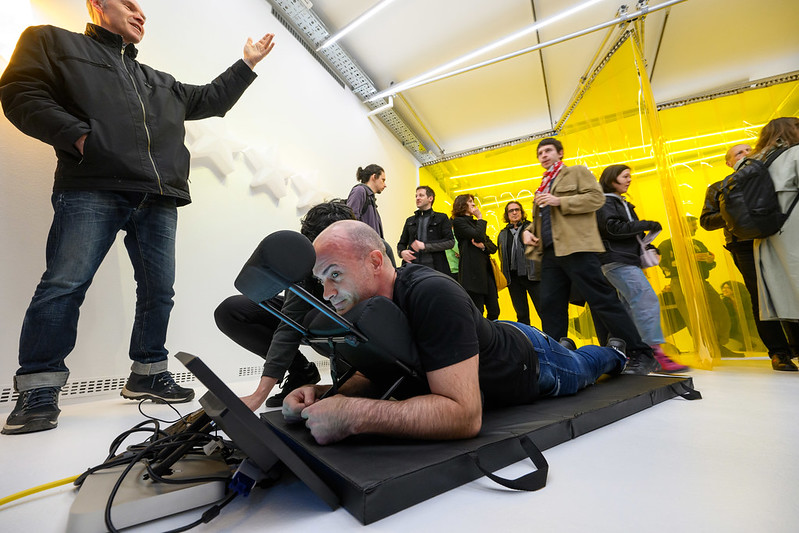
Opening of the exhibition One Star Review Tour. Photo: Domen Pal / Aksioma
How did people in Ljubljana react to the work, the tours and to discovering the awful comments tourists make about their city?
Carmen: We learnt to anticipate how people react to the work from our experience on Vis where we presented the work as a performance walk. We invited people to join us on a walk through the city. We took them to poorly rated spaces in the city and then we read the critical reviews out loud.
Doma: We made the big mistake of printing some reviews on banners and walked around holding them up.
Carmen: People felt very offended. They didn’t distinguish between us reading comments written by other people online and us. In Ljubljana, the work takes the form of an exhibition inside an art space. This helps to distance us from the comments, compared to having us physically bring the comments into the streets of a city. In Ljubljana, people understood the humour of the work, maybe because the format was installation-based…
Doma: With the installation at Aksioma, we promised people a 5-star experience for a 1-star show. It’s this false promise that can never be fulfilled because being massaged in an exhibition is in fact an intimidating experience. Other people are watching you. It’s all a bit wrong. We wanted to recreate this feeling we get when dealing with digital apps. They always promise the ultimate experience where everything works perfectly. But when you start to think about that, you’re actually feeling uneasy.
Selena: We worked a lot on the modes of conversations, looking for ways to activate conversations. I don’t know if we found the solution in Ljubljana, but the format facilitated the exchanges with the visitors of the show. The massage chair element has several layers. It embodies the airport logic, its aesthetic and its dimension of being a non-place. You like the idea of a massage chair or an airport, but you never really want to spend time there. You want to fly – you don’t want to be at the airport. We don’t really want to be in the massage chair either. We want to have been massaged. Massages can be painful. The setup of the exhibition in Ljubljana puts the weight on the chair and other objects that mediate the uncomfortable conversation about people’s disappointment. The ASMR video also has the same purpose.
Doma: Images of Google offices also inspired us. In Zurich, where Google is producing some of its Google Maps software, for example, they are working in this fake environment.
Carmen: In their Zurich offices, the local environment is reflected not by engaging with the local community, but by introducing Swissness to the office by furnishing it with cable cars and fake snow.
Doma: The cable cars even have graffiti on them. Visually, everything hurts. Nothing good can come out of a place like that.
Carmen: I think that, in a way, Google Maps infantilises tech space in the same way as they do with their offices. They make you rate stuff from 1 to 5, using unclear criteria. It all becomes non-specific. Even the rating becomes a cliché of itself. In Ljubljana, there’s this Dragon Bridge and people are seriously and incredibly offended by this bridge because they feel that the dragons are too small. If it’s called Dragon Bridge, they expect big dragons. To me, this is absolutely hilarious. How exactly does the bridge have to be to be regarded as “correct”? I wonder whether the people working at Google offices go out and expect Switzerland to conform to their idea of a country with fake snow, cable cars and graffiti. Switzerland is a multi-layered place like any other, it’s never going to be this cliché of itself.
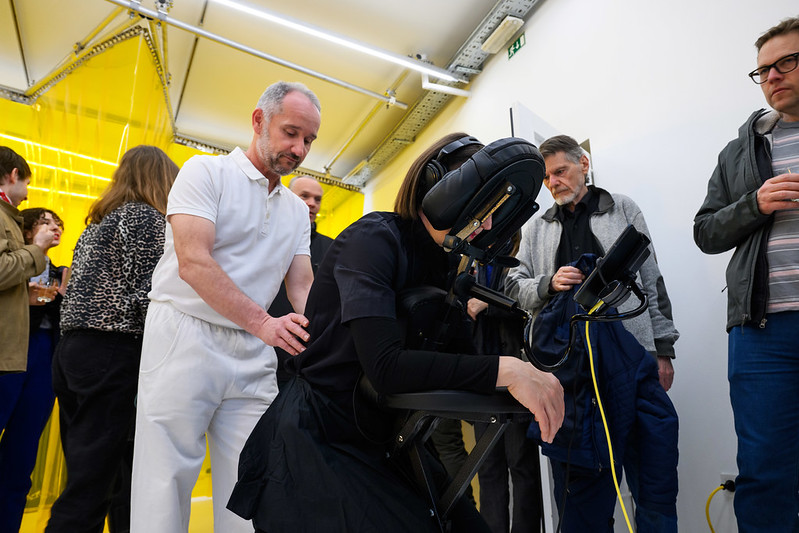
Opening of the exhibition One Star Review Tour. Photo: Domen Pal / Aksioma
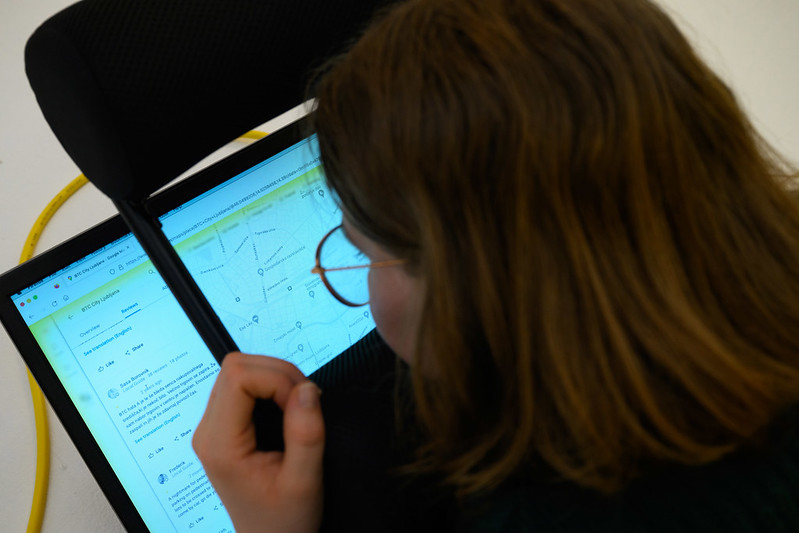
Opening of the exhibition One Star Review Tour. Photo: Domen Pal / Aksioma
When reading the project description, I thought, “Wow! That sounds hilarious!” The video of the review tour was indeed really fun to watch. Soon enough, however, I realised that the humour is an entry point into reflections about colonialism, collective and common good, resistance to the power of the tech industry, flatness of touristic experiences, etc. Is the work a call to resistance or does it have a different purpose?
Carmen: For me, it started with a basic question we all had during this research: “Where are the spaces where we could have this conversation?” After the Vis experience, we simply wondered, “When did we agree to this strange system where we busy ourselves on our phones rating places?” That’s why we wondered where, with whom and how we could have a conversation.
Doma: To enable critical action. All these systems function within a black box and you’re not exactly sure how they work. But it is also part of our interest to figure out how these systems function so that we can fundamentally criticise them. We also want to use them against themselves. For Carmen and me at least, this is part of the curatorial project (Un)real Data – Real Effects that we are developing at Aksioma at the moment. We also try to point out that you need to understand how the algorithmic regime works to be able to address critiques.
There was one work by Simon Weckert where he walked down a street with 100 mobile phones in a handcart to produce a traffic jam and create this utopia of an empty street. This project made us wonder, “When did we agree that Google uses our movements to optimise the traffic feature of Google Maps in Germany?” “Who decided that this is okay?” Our research looks at examples from the arts but also examples from activists to see how we can better scrutinise that field.
Selena: We also found a certain joy in collecting these examples. There is resistance to these oppressive, extractive practices of companies like Google or Facebook that provide free online infrastructure. They say they offer services for free, but what they do is give us the possibility to transform our lives into data so that they can mine and use the data. How about we collect that stuff ourselves? How about we curate that collection? What can we do with it? We also noticed that other people do similar things. For example, some people collect online negativity and turn it into beautiful products, like a book, for example. You can bring something positive to the world by collecting negativity and presenting its poetics.

Selena Savi?, Gordan Savi?i? and !Mediengruppe Bitnik, 1  Review Tour Ljubljana, still, 2024. Image: courtesy the artists
Review Tour Ljubljana, still, 2024. Image: courtesy the artists

One Star Review Tour. Exhibition view. Photo: Domen Pal / Aksioma
Is Google Maps now bigger than Tripadvisor for reviews?
Gordan: Yes. For Vis, we scraped both Tripadvisor and Google Maps. But for the Ljubljana show, we found that most of the reviews on Tripadvisor were about restaurants and guided tours. We were more interested in looking at the concept of public space and there was definitely more content posted to Google Maps.
Selena: Google review types are very diverse, you can review anything there. As Carmen explained earlier, on Google, you can review your tax office. That doesn’t happen on Tripadvisor.
Carmen: For most people, Google Maps is not an additional app. People who have an Android phone need a Google address anyway, so they can automatically rate stuff on Google Maps. It’s very convenient.
Gordan: During the research for Ljubljana, we had a scraping phase to collect the data, but we also developed a browser extension.
Doma: It hasn’t been published yet. We’re still working on it.
Gordan: It’s a simple intervention. The extension filters out positive reviews, so anywhere you click, you will get one-star reviews. It also obfuscates the specific Google UI elements, which get a bit blurred This adds to the distorted vision. One-star reviews are usually at the bottom and you have to scroll down to find them. But they are not removed, probably to maintain an air of authenticity. The browsing extension puts them straight into your face. And it works for everything: hotels, supermarkets, fast-food restaurants… not just for public spaces.
Doma: We received a very bad rating about the browser extension. It said that it gives you a nightmare vision of your own city.
Selena: This negativity is, I think, reflected in the title (Un)real Data. Real Effects. These negative reviews feel more real than the positive ones. During this work, we learned that you can easily buy a five-star review, but you cannot easily outsource one-star reviews. They are more difficult to sneak in as fake, so they tend to reflect real people’s experiences. Negative reviews are about the specificity, the edge of a place. If you read that the dragons on the bridge are small, then you can set your expectations and have a clearer idea of the bridge. If you’re a tourist with a generic imaginary of a bridge with dragons, you may picture a huge dragon, but the one-star review will tell you that you don’t need to even go there.
I come from Liège. I like the city but I would never expect people to tell me the city is beautiful. I wonder what One Star Review Tour would be like if you made it in a city that’s already a bit one-star anyway.
Gordan: One review about Parc d’Avroy in Liège says, “It looks good on Google Maps, but in real life, definitely not.” This qualifies for “one-star poetry”.
The exhibition engages with the power of reviews to produce real effects. It is part of the programme (Un)real Data – Real Effects in which !Mediengruppe Bitnik looks at how producing specific data can become a means to intervene in data-driven systems. What does it look like to produce data that has tangible impacts on the world? Is this something you practise in your daily life? Is this something anyone can do in their daily life?
Carmen: On a certain level, we all do this. For example, since we’ve finished setting up the exhibition, I’ve been battling the YouTube algorithm because now it only recommends videos of massage chairs, which are not interesting to me anymore. I don’t need to do more research on massage chairs now. I want to get out of the massage chair loop to see other stuff. We do consciously or unconsciously understand how these algorithmic systems work, and we move them in a direction that is interesting to us.
Another example is people who are really good at googling for information. I need 4 to 5 attempts to figure out the right search terms and get what I’m looking for. However, some people understand how these algorithms work much better. However, these algorithms change all the time, so we constantly have to adapt. In a way, we are spoiled here. The European Union has implemented minimal measures to protect us against these algorithmic systems. There are places where people are probably better at curating their data simply because it is a necessity: if they want to navigate the credit or evaluation systems they are submitted to, they need to be careful not to disclose bad data about themselves. Likewise, people who work directly under an algorithmic regime, also tend to “curate” their data. For example, if you are a delivery driver for one of the food delivery companies, you must pay attention not to cycle too fast and to cycle at the same speed every day. Otherwise, the algorithm will assign you longer distances for shorter times and you will be paid less for the kilometres. These riders need to find a sweet spot. I think these practices are part of everyday practices we are all learning and adopting.
Doma: Sometimes, people don’t even know they are using these tactics. When we speak with young students, we realise that many of them have a public Instagram account which they keep clean. They know they cannot be too explicit because it could harm them when they look for employment in 2 years or 10 years. And then they have another account where they write about political issues and where they do not use their real name. People might not always be fully conscious of these practices, but they are still using them.
Carmen and I are collecting these stories. In a previous project, we worked on social media algorithms. For example, in the job application system, it is very good when applying for a job to copy the original job posting as a watermark into your job application. Many of the applications are algorithmically evaluated, so when all the keywords are present in your application, the algorithm rates it higher.
Carmen: The human does not see the watermarks, but the algorithm does.
Doma: This example shows one of the many ways that people develop when they want to use the algorithm for their own benefit. These sorts of creative daily life strategies are very inspiring for us.
Does it mean that, contrary to what the mainstream media claims, younger people have developed greater media literacy?
Carmen: Just like young people are sharing cheat sheets about games, they are also circulating cheat sheets about Instagram and other social media.
Doma: You also see how many people are leaving the main social media platforms. Some might still perform there, but they prefer to share important content in private chat groups. People are moving away from the idea that everything needs to be shared and visible. They know they need to find a safer place. The rather stupid expression “Balkanization of the internet” is often used to describe this phenomenon.
Gordan: After all, the One Star Review Tour brings light to the darker side of what we call the “review regime” by exposing and discussing the rating complex within the video essay that is featured in the show. Our compilation is funny, but there are also reviews that were used to blackmail someone and extort cryptocurrency. At the same time, it’s been used as a place to critique the British Museum for the colonial origins of its collections, among other museum collections. These review systems create spaces where people randomly bump into each other. These are interesting movements.
Thank you, Selena, Doma, Carmen and Gordan!
One Star Review Tour, by !Mediengruppe Bitnik, Gordan Savic?ic?, Selena Savic? closed last month but BPM by Total Refusal, the last show in the (Un)real Data – Real Effects exhibition series opens on 15 May and will run until 14 June 2024 at Aksioma | Project Space, in Ljubljana.
Previously: Hardly Working: Are we the NPCs (non-playable characters) of our own system?
Source


 Review Tour Ljubljana, still, 2024. Image: courtesy the artists
Review Tour Ljubljana, still, 2024. Image: courtesy the artists




















 ”
”





